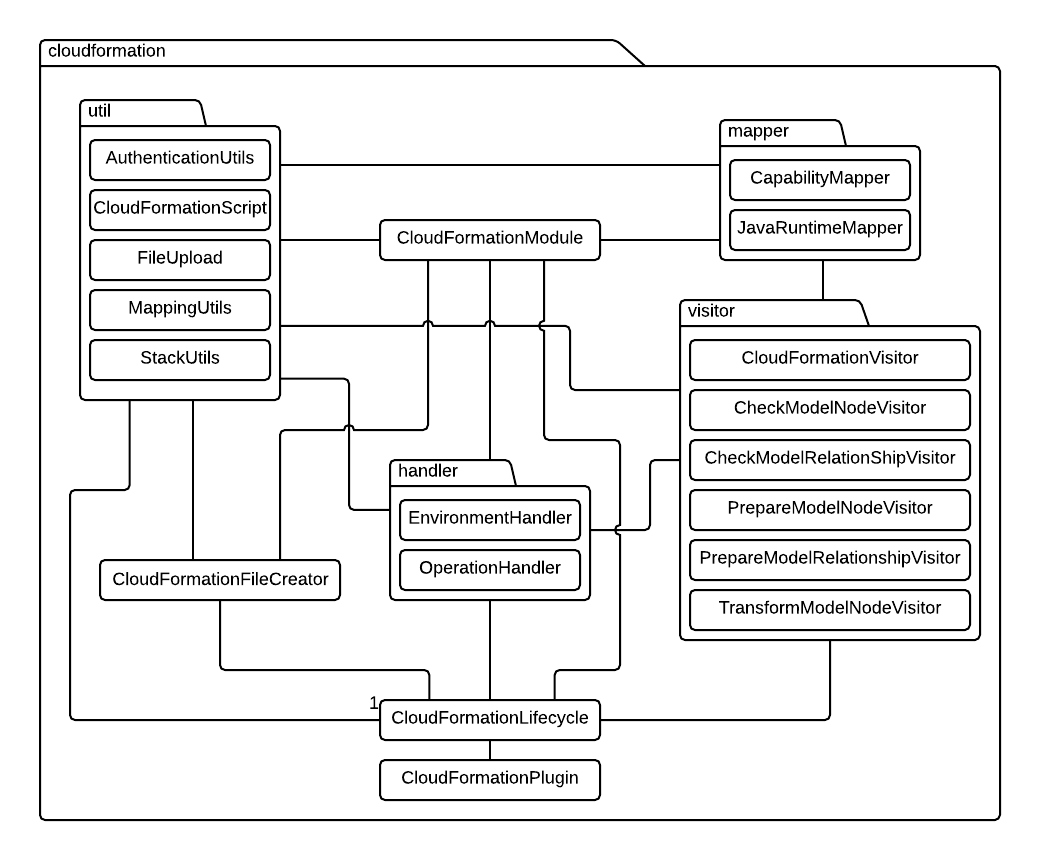Architecture
In this section, we'll discuss the basic architecture of the CloudFormation plugin as well as the basic roles of the various classes that constitute it.
The following is simplified UML diagram of the cloudformation package:

Cloudformation package
The cloudformation package is the basic package of the CloudFormation plugin. It contains the CloudFormationPlugin, CloudFormationLifecycle, CloudFormationModule and CloudFormationFileCreator classes.
CloudFormationPlugin
CloudFormationPlugin is an extension of the ToscanaPlugin class representing the CloudFormation platform. The following are the platform properties of the CloudFormation plugin:
- The
AWS Regionwhich determines where the transformed model will run in - The
AWS Access Key IDand theAWS Secret Keywhich are the credentials used to communicate with AWS during the transform phase of the transformation lifecycle - The
AWS Keypairwhich, if set to true, makes sure that the EC2 instances can be accessed via SSH with a valid AWS EC2 Keypair.Note: If the
AWS KeyPairproperty is set to true, the name of your AWS EC2 Keypair must be manually replaced in thecreate-stack.shscript of the target artifact before deployment.
CloudFormationLifecycle
CloudFormationLifecycle is an extension of the AbstractLifecycle class which contains the lifecycle phases that are executed if the user initiates the transformation procedure.
For further information about the behaviour of the CloudFormation plugin during each of these phases, please refer to the transformation workflow.
CloudFormationModule
CloudFormationModule is an extension of the Module class of the cloudformation-builder. Originally, it was used in order to represent the Java model of a CloudFormation template, but in order to fulfil the needs of our plugin, we extended it with additional fields and methods needed to facilitate the deployment of our template. During the transformation, it gets filled with the information in order to create the CloudFormation template and any additional files needed for deployment.
Visitor package
The visitor is used to iterate over the EffectiveModel during the TransformationLifecycle.
CloudFormationVisitor
CloudFormationVisitor is the abstract superclass for all visitor classes. It contains the Logger to log messages while visiting and all visitors iterate over the Topology of the EffectiveModel. There are also various utility methods to be used by the visitors during the transformation lifecycle.
The behaviour of the specific child classes of the CloudformationVisitor are explained in detail in the transformation workflow.
Handler package
The handler package is used to handle the transformation of TOSCA operations. It contains the EnvironmentHandler and OperationHandler classes. The behaviour of these handler classes is explained in the Transformation by TOSCA type chapter.
Mapper package
The mapper package is used to map TOSCA CapabilityTypes and the JavaRuntime NodeType. It contains the CapabilityMapper and JavaRuntimeMapper classes. The behaviour of these mapper classes is explained in the Capability Mapping and JavaApplication of the Transformation by TOSCA type chapter.